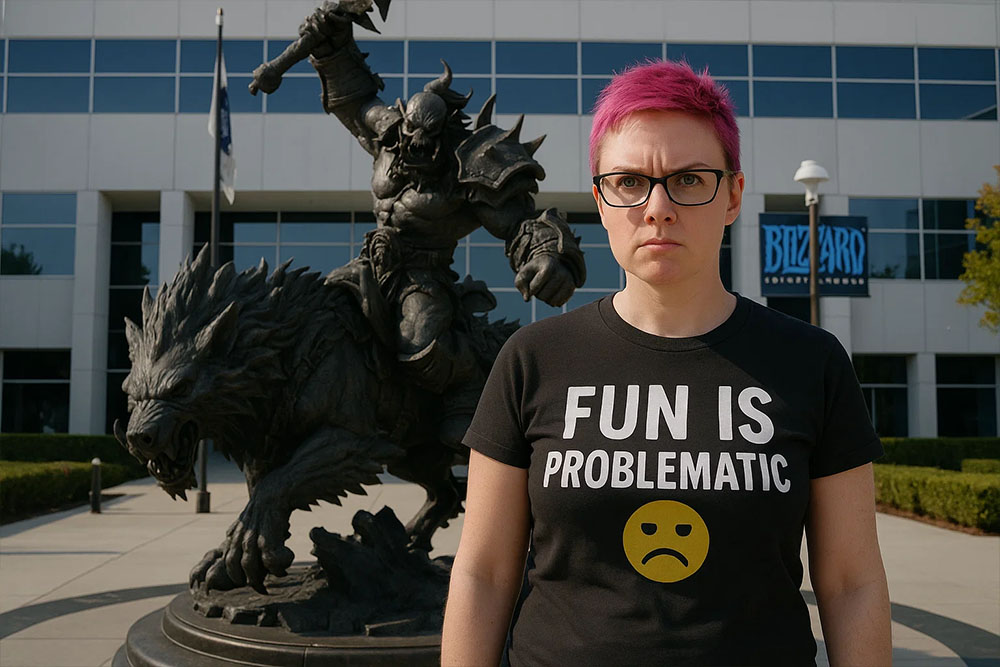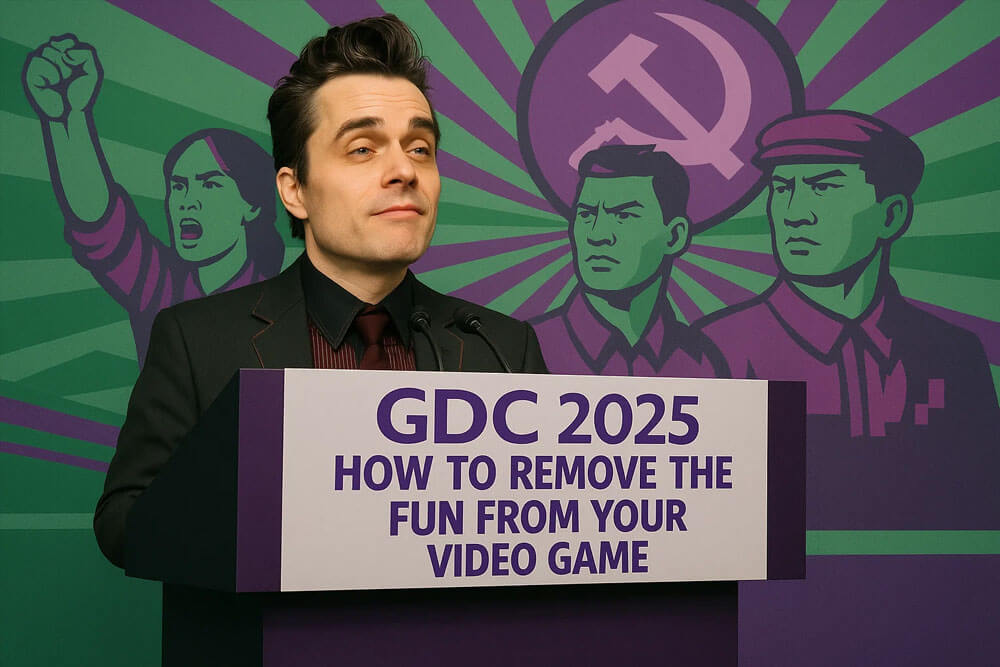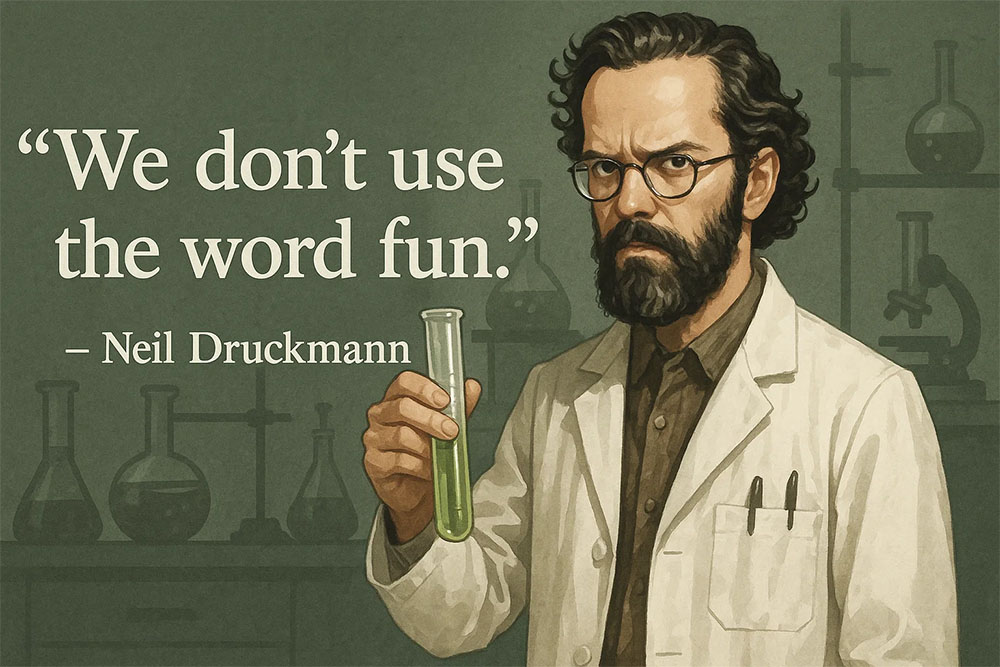Every crime has a smoking gun. Every revolution has its manifesto. And every ideological capture has its moment of insertion — the point where the parasite first enters the bloodstream. For years, gamers have wondered: how did the industry we loved become so obsessed with identity, grievance, and politics? When did fun become optional — even suspicious?
Many point to 2014’s Gamergate as ground zero — the flashpoint where the culture war exploded in the gaming sphere. But Gamergate wasn’t the beginning. It was the backlash.
But the real beginning came earlier. Much earlier.
The War on Fun
For a long time, the process of making fun was considered a noble pursuit — even a moral one. Game developers weren’t just engineers or entertainers; they were architects of joy, curiosity, and challenge. Many of us entered the field after reading Raph Koster’s A Theory of Fun for Game Design, a masterwork that treated fun not as frivolous distraction but as a deep, cognitive process — learning wrapped in delight. In those days, designing a game that made people smile, think, and lose track of time was seen as a worthy calling. It meant you were doing something right.
Then something changed.
It didn’t happen overnight. It crept in through trade journals, university programs, and industry panels. Suddenly, “fun” was framed as unserious, even suspect — a tool of privilege or an obstacle to enlightenment…

At its core, the rejection of fun wasn’t just political — it was aspirational. These critics and theorists didn’t want to be seen as entertainers; they wanted to be recognized as serious artists, cultural architects, and moral educators. Fun was too common, too unserious, too juvenile for their ambitions. So they framed it as a distraction from the higher calling of critique and representation. By denigrating fun, they elevated themselves.
Once they cast off fun as frivolous, they made room for what they considered serious. Suddenly, games weren’t about challenge or joy — they were about Gaza, gay rights, colonial guilt, and gender identity. Entertainment was rebranded as escapism, and escapism became suspect. If your game wasn’t confronting a sociopolitical issue, it was dismissed as outdated or irresponsible. This was never about expanding the medium. It was about replacing it.
I was recently made aware of a disturbing article that sheds light on the current war on fun in the video game industry courtesy of game dev Artur Smiarowski:
In 2007, an article was quietly published in Game Developer magazine — the official trade publication of the industry. Its title? Who Says Video Games Have to Be Fun? Written by Bryan Ochalla, the piece is a jaw-dropping early example of how progressive ideology wormed its way into game design under the guise of intellectualism and seriousness.
It’s all there:
- The dismissal of “fun” as the primary goal of gaming
- The promotion of “queer games,” even in 2007
- The call to elevate games as tools for social change
- And the reliance on university voices and theorists — not developers — to dictate the new direction
This wasn’t just a quirky think piece. It was a blueprint for cultural colonization.
And someone at Game Developer approved it. An editor looked at this radical redefinition of the medium and said: yes. Let’s run this. Even in 2007, they knew it would be controversial — and they published it anyway.
That’s your smoking gun. That’s when the industry stopped asking, “Is it fun?” and started asking, “Is it righteous?”
It would take years for the consequences to fully unfold. But the ideological pathogen had entered the bloodstream.
And I know, because I saw the early symptoms firsthand.
The Article That Said the Quiet Part Out Loud
Buckle-up folks, we have a winding, weird rabbit hole to explore that would make Lewis Carrol proud.
Bryan Ochalla’s 2007 piece, “Who Says Video Games Have to Be Fun?”, wasn’t written by a lead designer or creative director. It wasn’t penned by someone with a shipped title or a major development credit. Ochalla was a journalist, not a developer — and according to his LinkedIn profile, he’s still not a developer.
He was also openly gay, contributing to (now defunct) sites like GayWired and later writing explicitly about being “out in the industry.” In other words, he was not some dispassionate observer — he had a personal and ideological stake in promoting identity-driven game design. But that didn’t stop Game Developer magazine — a trade journal for working professionals — from giving him a platform to declare that games didn’t need to be enjoyable.

The article is a Trojan horse. It pretends to be a casual exploration of “serious games,” but it quickly reveals its purpose: to delegitimize fun as the default value in game design and replace it with ideological messaging.
Ochalla elevates games like Darfur Is Dying, a browser-based game about genocide, and Peacemaker, a game about the Israeli–Palestinian conflict. These aren’t games in the traditional sense — they’re political tools, wrapped in interaction. Their purpose isn’t to entertain, but to educate, shame, or convert.
He goes further. He introduces the idea of “queer games” — in 2007 — as a rising area of experimentation. This wasn’t just an outlier reference. It was an ideological flag planted on the hill of future culture war.
And yet, nowhere in the article is there concern for what makes a game playable, immersive, or emotionally satisfying. Ochalla isn’t interested in player agency or narrative brilliance — he’s interested in rhetorical games. His words: “games as a rhetorical medium.”
This is the language of the activist-academic class — those who see media not as a craft to be mastered, but as a tool to reshape the culture.
It’s no coincidence that everyone cited in the piece is from a university, a foundation, or a grant-funded program. Not one quote from a working game designer. Not one.
That tells you everything.
The Molleindustria Connection
Perhaps the most telling detail of all: the article favorably mentions a so-called game called Queer Power, hosted by activist developer Molleindustria. But Queer Power is not a game. Warning don’t click on the link: it’s a crude gay sex simulator featuring graphic depictions of intercourse and fellatio, albeit in stick-figure form. This was the depravity that Game Developer was promoting. Presented as a brave new frontier in game design, this was nothing more than digital exhibitionism posing as progressive art — and it was being held up as legitimate within the pages of Game Developer.
As it turns out, Molleindustria was never about making games — it was about making war. In his own 2003 manifesto, Paolo Pedercini described his studio’s mission as “the theory and practice of soft conflict — sneaky, viral, guerrillero, subliminal conflict — through and within videogames.” He called for “appropriating the production of games and using it against its masters,” turning gameplay into “playable theory.” His goal wasn’t fun. It was revolution.
And by 2014, the industry rolled out the red carpet. That year, the Game Developers Conference — supposedly a neutral platform for sharing tools and techniques — hosted a panel brazenly titled “Queering Games Subversively.” No ambiguity. No subtlety. The message was clear: use games as vehicles to inject queer theory and radical politics under the radar. Don’t entertain the player — manipulate them. Undermine “dominant culture,” destabilize norms, and call it design.
It’s no coincidence this was the same year Gamergate erupted. While the media painted it as a random burst of misogyny, what really happened was that players finally noticed the ideological rot seeping into their hobby. Panels like this weren’t the fringe — they were the plan. And they weren’t being challenged. Until now.

Molleindustria, the activist studio that also hosted Ochalla’s 2007 article and created Queer Power, isn’t a traditional game developer. It’s the personal ideological vehicle of Pedercini — an avowed Marxist who has openly stated that his work is about subverting capitalism through ‘soft conflict’ in games. Backed by the prestige and protection of academia, Pedercini doesn’t answer to players or markets. His funding comes from his university position at Carnegie Mellon, not consumers. That’s what makes Molleindustria so dangerous: it’s not constrained by audience, sales, or even basic playability. It exists to radicalize, not to entertain — and it’s been doing so for over 20 years.
Even after his controversial 2007 piece in Game Developer, Bryan Ochalla continued to advocate for identity-driven game content. In a 2009 article for The Advocate titled “Are Video Games Getting Gayer?”, Ochalla celebrated the increasing presence of LGBTQ+ themes in mainstream titles like Fable II and Persona 4, and expressed hope for more “inclusive narratives”. His consistent message was clear: the future of gaming lay not in broad, apolitical appeal, but in using games as a medium to advance cultural representation and personal identity. Far from being a one-time contributor, Ochalla remained active in shaping the discourse around what games should be — and for whom.
Brandon Sheffield: From Cinema Student to Gaming’s Moral Grand Inquisitor
It’s not enough to critique the ideology. You have to name its enforcers. And one name stands out more than any other in the long march through the video game industry: Brandon Sheffield.

Brandon Sheffield wasn’t a veteran game developer. He wasn’t even a junior designer. He graduated in 2003 with a BA in Cinema-Television Critical Studies and Japanese Language and Culture from USC — and by January 2004, he was Editor-in-Chief of Game Developer magazine. That’s barely a semester between student life and cultural gatekeeper. No shipped titles. No dev team experience. Just a degree in media theory and a lot of opinions. And yet somehow, he was handed the keys to the industry’s biggest professional platform. On what basis?
While most players only began noticing the shift in games around the time of Gamergate, Sheffield was already inside the fortress — shaping the editorial voice of Game Developer magazine and opening the gates to ideological subversion.
He most likely greenlit the aforementioned Bryan Ochalla’s 2007 tract dismissing “fun” as outdated. The article mentioned “queer games” like Queer Power, a graphic gay sex simulator inspired by post-modernist Judith Butler — a woman whose entire academic legacy is built on dismantling Western categories of gender, family, and meaning.
Long before Anita Sarkeesian brought feminist film theory to YouTube with her Tropes vs. Women series, Brandon Sheffield was already planting the seed. On June 28, 2012, in a Game Developer article titled “Are We Men or Boys?“, Sheffield invoked the “male gaze” — a concept pioneered by Marxist-feminist theorist Laura Mulvey — to critique the depiction of women in games. This wasn’t a reactive opinion. It was proactive ideological engineering, published years before Sarkeesian’s now-infamous Body Language & The Male Gaze video debuted in 2016. Sarkeesian didn’t invent the critique — she amplified it. But it was Sheffield who first smuggled it into the bloodstream of the industry, using his editorial perch to reframe masculine fantasy as moral failure.

But the “male gaze” was never the real issue — not really. Sheffield and his ideological peers didn’t object to eroticism in games per se or the “gay gaze.” They objected to heterosexual male desire. That was the real enemy: masculinity itself. Normal men. Players like you and me.
Sheffield’s entire career has been one long act of allyship theater — moral grandstanding to curry favor with every new activist wave. He publicly decried the presence of “booth babes” at industry events like E3, framing them as evidence of lingering sexism in the gaming world. He canceled a Wii U release over a political firing. And now, after helping poison the well of AAA gaming, Sheffield is headlining a talk at GDC 2026, ready to spread the same ideological rot into indie circles.
He’s not done destroying. He’s just switching targets.
There’s a reason someone like Brandon Sheffield gained outsized influence. As the saying goes, “In the land of the blind, the one-eyed man is king.” The video game industry had grown into a cultural juggernaut, but its journalism lagged far behind — more fanboy commentary than serious critique. There were no standards, no intellectual backbone, and no real resistance. Into that vacuum stepped activists and ideologues who spoke with certainty, cloaked in the language of academia and moral urgency. It wasn’t merit that elevated them. It was timing — and a complete lack of competition.
Brandon Sheffield has never faced real scrutiny. For years, he’s been allowed to push his ideology uncontested — because no one dared challenge the narrative. Critics feared the usual labels. Developers stayed quiet to protect careers. And gamers, for the most part, had no idea who he was. But make no mistake: Sheffield’s influence has been profound, not because he earned it, but because no one stood up and said enough. This article is doing what the industry refused to do — tell the truth.
Why Sheffield Still Has a Platform
Gamers might wonder how someone like Brandon Sheffield — whose indie games are commercially obscure and whose audience credibility is thin — continues to be treated as a thought leader in the industry. The answer lies in the structure of cultural influence, not merit:
- Ideological Alignment: Sheffield says what institutions want to hear — reinforcing progressive orthodoxy on gender, identity, and inclusion. His value is symbolic, not commercial.
- Institutional Capture: From GDC to game schools to trade magazines, many industry platforms were overtaken by activist narratives years ago. Sheffield was an early adherent and became a fixture.
- Persona Engineering: By positioning himself as a critic who “cares” about games as message-bearing art, he earns soft power in media circles that reward moral alignment over mass appeal.
- Performative Authority: Through writing, speaking, and posturing with certainty, he maintains a facade of expertise. For journalists and academics who don’t game, that’s often enough.
- Audience Contempt: Ironically, Sheffield’s inability to appeal to traditional gamers boosts his credibility in activist circles. Disdain for the core audience is viewed as moral superiority — not market failure.
In short, Brandon Sheffield doesn’t thrive despite alienating the audience. He thrives because he does.
The Politburo of Gaming — And the Cowards Who Let It Happen
While working developers were crunching late nights to build playable, entertaining games, a new class of ideologues was forming just outside the production pipeline — circling like vultures. They weren’t artists, coders, or animators. They were bloggers, critics, and activists. And they had a different mission.
Kotaku. Polygon. The Escapist. Gamasutra. Game Developer. These platforms became the ideological command centers — a kind of cultural politburo for the gaming industry. They didn’t make games. They made narratives. And then they distributed those narratives through every available channel, from op-eds to award panels.
While developers were too busy building, this politburo had time to ponder its own place in the world — and how best to radicalize popular culture. They preached representation. They policed language. They celebrated “games that aren’t fun.”
As someone who worked in the trenches of this industry, I can tell you: we didn’t have time to sit around and ‘reimagine the medium.’ We had builds to make. Milestones to hit. Bugs to squash. Cold pizza to eat. The luxury of activism belonged to those who weren’t actually making games.
But this quiet takeover didn’t succeed on ideology alone. It thrived because those at the top let it happen.
Where Were the CEOs?
They were supposed to be the gatekeepers. Instead, they took the path of least resistance. They let the activists drive the narrative while they chased ESG scores, PR wins, and internal peace. By the time they realized the culture had shifted, it was too late.

The result? Fun was rebranded as problematic. The audience was labeled toxic. Developers were silenced and even cancelled. And the activists were promoted.
Retiring the Player — Another Smoking Gun
One year before Gamergate erupted, another quiet but calculated narrative shift took place: an article appeared on where else but Game Developer titled Let’s Retire the Word Gamer. And who wrote it?
Brandon Sheffield.
Yes — the same editor who platformed gay activist Ochalla, denounced the “male gaze,” recently attacked the upcoming GTA 6, and is scheduled to give a lecture at the upcoming GDC 2026. Once again, Sheffield was at the vanguard of the ideological redefinition of gaming. Only this time, his target wasn’t just games — it was gamers themselves.
The article argued that the term “gamer” was outdated, exclusionary, and no longer useful. On the surface, it sounded like harmless branding talk. But in truth, it was a declaration of war on the very people who built the industry — the hobbyists, the nerds, the RPers, the modders, LAN warriors, and MMORPG raiders who gave gaming its soul. The men who created the video game industry were deemed “problematic” and discarded like trash and replaced.

This piece laid the rhetorical groundwork for the now-infamous 2014 media campaign where dozens of outlets simultaneously declared that “gamers are over.” That wasn’t spontaneous. It was coordinated to provide a distraction to the growing Gamergate scandal. And Sheffield’s article helped set the tone.
First, they told us games didn’t have to be fun. Then they told us gamers didn’t deserve to exist.
This wasn’t about expanding the audience. It was about seizing the medium — and pushing out the people who wouldn’t comply.
The Legacy: From Manifesto to Mainstream
And the legacy of Ochalla’s piece didn’t end with the indie circuit or grant-funded prototypes. It found its way into the halls of AAA development. Consider this telling quote from The Last of Us Part II director Neil Druckmann:
“We don’t use the word fun.”
And he continues:
“What makes us unique is everything we do from gameplay to art to story is ultimately in service of a message; there’s something we’re trying to say.”
That’s the ideology, fully matured. Not entertainment, but indoctrination. Not play, but pedagogy. Druckmann isn’t an outlier — he’s the end product of a cultural shift that began years earlier, when critics and academics stopped asking how to delight players and started asking how to correct them.

Why They Do It
For many gamers, the question isn’t just how the industry changed — it’s why.
Why did people who weren’t part of the creative engine feel compelled to redefine the medium? Why did they infiltrate joyful, apolitical spaces only to strip them of their spirit?
The answer lies in understanding that this isn’t just activism — it’s a new form of religion:
- Moral Absolutism Repackaged: Traditional religion may have declined, but its moral architecture has been repurposed. These activists don’t want better games — they want correct games.
- Personal Therapy Externalized: Their identities are central to their worldview. Rather than heal through introspection, they seek validation through media. If a game doesn’t affirm them, it must be remade.
- Control Without Creation: They don’t ship games. They critique them. This grants them power without the risk or effort of creation.
- Redemptive Narcissism: They’re not critics — they’re missionaries. Everything becomes a crusade.
- Power Through Guilt: Accusation is a shortcut to control. If joy is privilege, then fun must be policed.
Conclusion: Naming the Root and the Gardener Who Watered It
For years, gamers sensed something was off. The characters changed. The stories got preachy. The joy drained out of the worlds they once loved. And when they asked why, they were mocked, shamed, and silenced.
Now we know why.
It didn’t start with The Last of Us Part II. It didn’t start with Gamergate. It started with an academically sanctioned ideology — one that viewed fun as frivolous, masculinity as toxic, and players as problems to be corrected.
It began with Judith Butler, the postmodern theorist who declared gender a performance and truth a power play. It was seeded by activist developers like Paolo Pedercini, who viewed games as Trojan horses for revolution. And it broke ground with Bryan Ochalla’s bizarre 2007 article, Who Says Video Games Have to Be Fun?, which slipped radical theory into the bloodstream of an entire industry — under the guise of intellectual critique. Ochalla could’ve saved himself the trouble if he’d simply read Raph Koster’s A Theory of Fun for Game Design.
But ideas don’t spread on their own.
They need gardeners.
And the industry had plenty — a cabal of green-thumbed progressives, critics, and cultural opportunists who saw the games industry not as a creative frontier, but as a soft target for ideological capture. These weren’t brilliant minds or seasoned developers. They were media-school graduates, moral exhibitionists, feminist opportunists, and credentialed nobodies with the right opinions and the right connections. People like Brandon Sheffield, Jason Schreier, and their ilk — a star chamber of unimpressive but well-positioned insiders — quietly seized control of the intellectual and moral direction of the medium.
It wasn’t talent that gave them power. It was timing. It wasn’t earned authority. It was inherited access. And they used it not to nurture gaming’s creative potential, but to prune it into conformity.
One man who watered those roots — who opened the gates, curated the narrative, and redirected the soul of an entire industry — was Brandon Sheffield.
As editor of Game Developer magazine, Sheffield didn’t just reflect the industry’s drift. He steered it. He chose which voices were amplified, which ideas were platformed, and which values were smuggled in under cover of progress. He wasn’t a designer. He wasn’t a coder. He was the gatekeeper — the gardener who mistook ideology for insight, and used his perch to fertilize both.
This wasn’t a coincidence. This wasn’t a blunder.
It was a cultural heist.
And now, at long last, the dots are connected, and the paper trail is visible.
—Wolfshead






I didn’t know this guy, it seems you again were faster than most when it comes to identifying the roots and core of this activist crusade.
This shows this is an outside-assault on gaming and gamers itself. Part of the larger cultural war, nothing gets left untouched and untainted.
The disdain for fun, games, everything… the activist face and gaze is always quite angry and hateful. Guess this is why, quite in Marxist tradition, they accuse everyone of hatemongering. Because that is what they do.
I am a bit at a loss for words, excellent article. This article resonated with me and made me angry at these guys and gals. Also, kudos for finding one of the few photos where Judith Butler is kind of smiling and not angry, one doesn’t see that often.
When I was young, blogs were full of debate about game design, how to improve this, about how to build worlds, we talked about theories like Bartle test and all that. It was highly creative and entertaining. I, I also believe nobody else either, had POLITICS in mind for one moment. In fact, I needed to get decades older to finally bother with politics at all, maybe a mistake.
Games journalists were initially fans. They were like us. Games magazines flourished. Then the snobbery and intellectual bull began. Students of the most absurd and strange studies, like the one mentioned in the article, took slowly over.
At this point in time the scores given by games magazines are as far away from the audience’s perception as the so-called modern art from beauty.
Let’s see if Amazon manages to destroy the Fallout series. So far nothing they touched has stayed untainted by wokeness for more than one season. It is time that Naughty Dog crashs and burns, the games industry still doesn’t quite get it or too often bullies studios into compliance, see how Kingdom Come Deliverance 2 bowed preemptively. I still think they must get another writer, how on Earth to make a game about the Middle Ages and put so much woke stuff into it. I still haven’t touched it and likely never will.
Expelling that ideology from gaming will take a while, but I cannot get rid of it soon enough. Young gamers deserve better games than what they can get right now.
I used AI to make that image of Judith Butler. She’s a dour, nasty person living in her self-created hell. I doubt she’s ever smiled.
I grew up with Computer Gaming World magazine. I was there from pinball machines to Pong in arcades. I remember a world before the Internet when sanity was the default. I hold the memories of innocent and fun video games close to my heart before the shadow of Mordor came.
The crazy thing is that nobody stood up to Sheffield, with the exception of KotakuInAction and KotakuInaction2 on Reddit. These cultural Marxists and postmodernistas were allowed to enter our hobby completely unopposed.
Even the good bloggers in the MMORPG world, like Lum the Mad (Scott Jennings), turned out to be hardcore leftists who brought with them their presumptions about life. The arts and entertainment industry seems to attract progressives.
I watched a recent podcast with Sheffield, Jason Schreier, and some others. It was atrocious how banal it was, considering how these people consider themselves the intelligentsia of our industry.
What happened to the video game industry is a tragedy, and we’re still surfing the consequences of it. I aim to document and critique as much of this as possible.